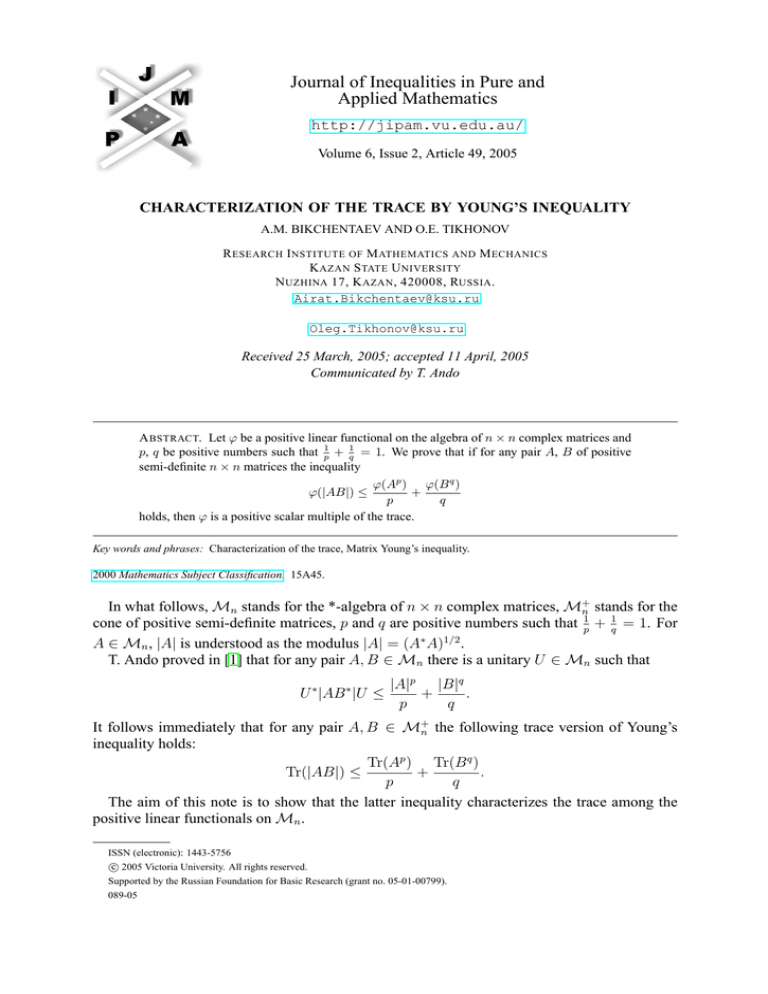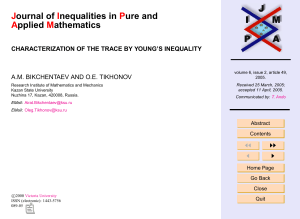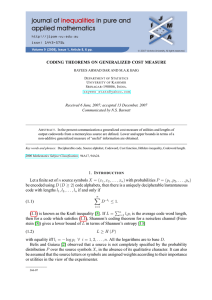
Journal of Inequalities in Pure and
Applied Mathematics
http://jipam.vu.edu.au/
Volume 6, Issue 2, Article 49, 2005
CHARACTERIZATION OF THE TRACE BY YOUNG’S INEQUALITY
A.M. BIKCHENTAEV AND O.E. TIKHONOV
R ESEARCH I NSTITUTE OF M ATHEMATICS AND M ECHANICS
K AZAN S TATE U NIVERSITY
N UZHINA 17, K AZAN , 420008, RUSSIA .
Airat.Bikchentaev@ksu.ru
Oleg.Tikhonov@ksu.ru
Received 25 March, 2005; accepted 11 April, 2005
Communicated by T. Ando
A BSTRACT. Let ϕ be a positive linear functional on the algebra of n × n complex matrices and
p, q be positive numbers such that p1 + 1q = 1. We prove that if for any pair A, B of positive
semi-definite n × n matrices the inequality
ϕ(Ap ) ϕ(B q )
ϕ(|AB|) ≤
+
p
q
holds, then ϕ is a positive scalar multiple of the trace.
Key words and phrases: Characterization of the trace, Matrix Young’s inequality.
2000 Mathematics Subject Classification. 15A45.
In what follows, Mn stands for the *-algebra of n × n complex matrices, M+
n stands for the
cone of positive semi-definite matrices, p and q are positive numbers such that p1 + 1q = 1. For
A ∈ Mn , |A| is understood as the modulus |A| = (A∗ A)1/2 .
T. Ando proved in [1] that for any pair A, B ∈ Mn there is a unitary U ∈ Mn such that
U ∗ |AB ∗ |U ≤
|A|p |B|q
+
.
p
q
It follows immediately that for any pair A, B ∈ M+
n the following trace version of Young’s
inequality holds:
Tr(Ap ) Tr(B q )
Tr(|AB|) ≤
+
.
p
q
The aim of this note is to show that the latter inequality characterizes the trace among the
positive linear functionals on Mn .
ISSN (electronic): 1443-5756
c 2005 Victoria University. All rights reserved.
Supported by the Russian Foundation for Basic Research (grant no. 05-01-00799).
089-05
2
A.M. B IKCHENTAEV AND O.E. T IKHONOV
Theorem 1. Let ϕ be a positive linear functional on Mn such that for any pair A, B ∈ M+
n
the inequality
ϕ(Ap ) ϕ(B q )
(1)
ϕ(|AB|) ≤
+
p
q
holds. Then ϕ = k Tr for some nonnegative number k.
Proof. As is well known, every positive linear functional ϕ on Mn can be represented in the
form ϕ(·) = Tr(Sϕ ·) for some Sϕ ∈ M+
n . It is easily seen that without loss of generality
we can assume that Sϕ = diag(α1 , α2 , . . . , αn ), and we have to prove that αi = αj for all
i, j = 1, . . . , n. Clearly, it suffices to prove that α1 = α2 . Inequality (1) must hold, in particular,
for all matrices A = [aij ]ni,j=1 , B = [bij ]ni,j=1 in M+
n such that 0 = aij = bij if 3 ≤ i ≤ n or
3 ≤ j ≤ n. Thus the proof of the theorem reduces to the following lemma.
Lemma 2. Let S = diag 12 + s, 12 − s , where 0 ≤ s ≤ 12 . If for every pair A, B ∈ M+
2 the
inequality
Tr(SAp ) Tr(SB q )
+
(2)
Tr(S |AB|) ≤
p
q
holds, then s = 0.
Proof of Lemma 2.
Let 0 ≤ ε ≤ 12 , δ = 14 − ε2 . Let us consider two projections
√ √ 1
1
−ε
δ
+ε
δ
2
2
√
√
P1 =
,
P2 =
.
1
1
δ 2 +ε
δ 2 −ε
Calculate |P1 P2 |:
P 2 P1 =
√ 2δ √ (1 + 2ε) δ
,
(1 − 2ε) δ
2δ
P2 P1 P2 = 4δP2 ,
hence
√
√
|P1 P2 | = 2 δP2 = 1 − 4ε2 P2 .
Substitute A = αP1 , B = βP2 with α, β > 0 into (2) and perform the calculations. Then the
left hand side in (2) becomes
√
1
αβ 1 − 4ε2
+ 2εs
2
and the right hand one becomes
αp 12 − 2εs
β q 12 + 2εs
+
.
p
q
1q
. Then we obtain as an implication of (2):
Now, take α = 1, β = 1−4εs
1+4εs
1
1√
1
1
(1 − 4εs) q (1 + 4εs) p 1 − 4ε2 ≤ (1 − 4εs),
2
2
which implies
p
1 − 4εs
(3)
(1 − 4ε2 ) 2 ≤
.
1 + 4εs
By the Taylor formulas,
p
(1 − 4ε2 ) 2 = 1 − 2pε2 + o(ε2 ) = 1 + o(ε) (ε → 0),
1 − 4εs
= 1 − 8εs + o(ε) (ε → 0).
1 + 4εs
J. Inequal. Pure and Appl. Math., 6(2) Art. 49, 2005
http://jipam.vu.edu.au/
C HARACTERIZATION OF THE T RACE BY YOUNG ’ S I NEQUALITY
3
Since we have supposed that 0 ≤ s, the inequality (3) can hold for all ε ∈ 0, 12 only if
s = 0.
R EFERENCES
[1] T. ANDO, Matrix Young inequalities, Oper. Theory Adv. Appl., 75 (1995), 33–38.
J. Inequal. Pure and Appl. Math., 6(2) Art. 49, 2005
http://jipam.vu.edu.au/












